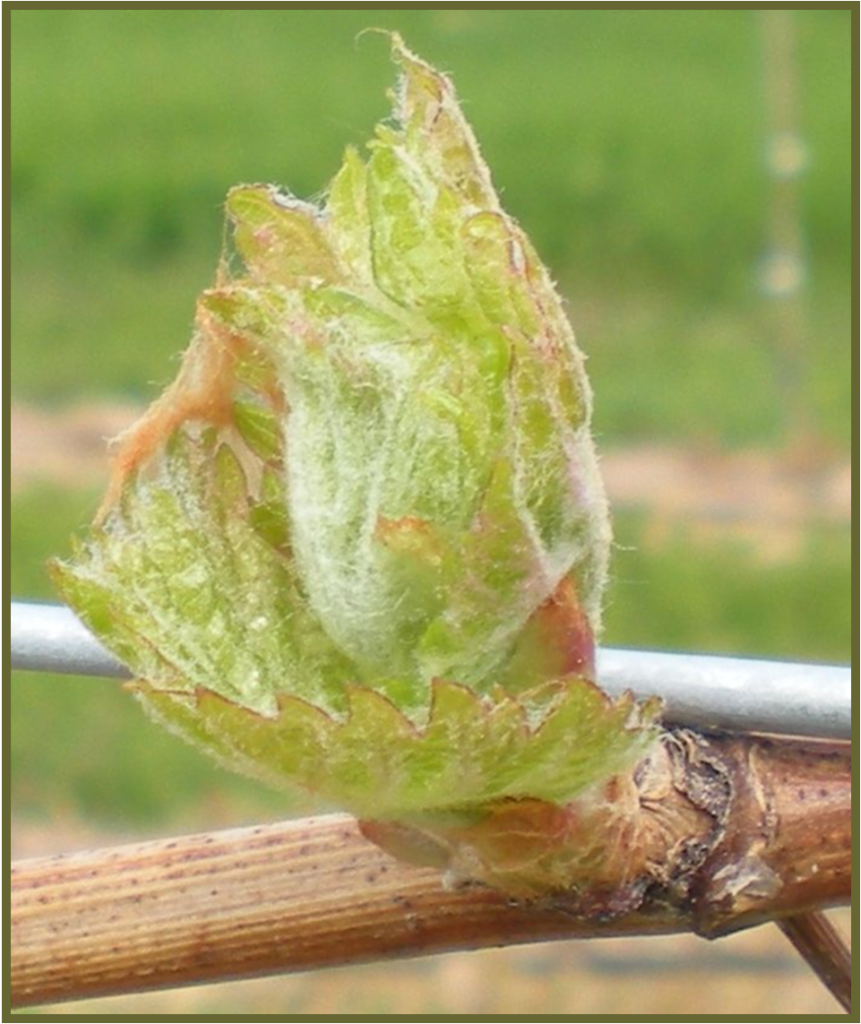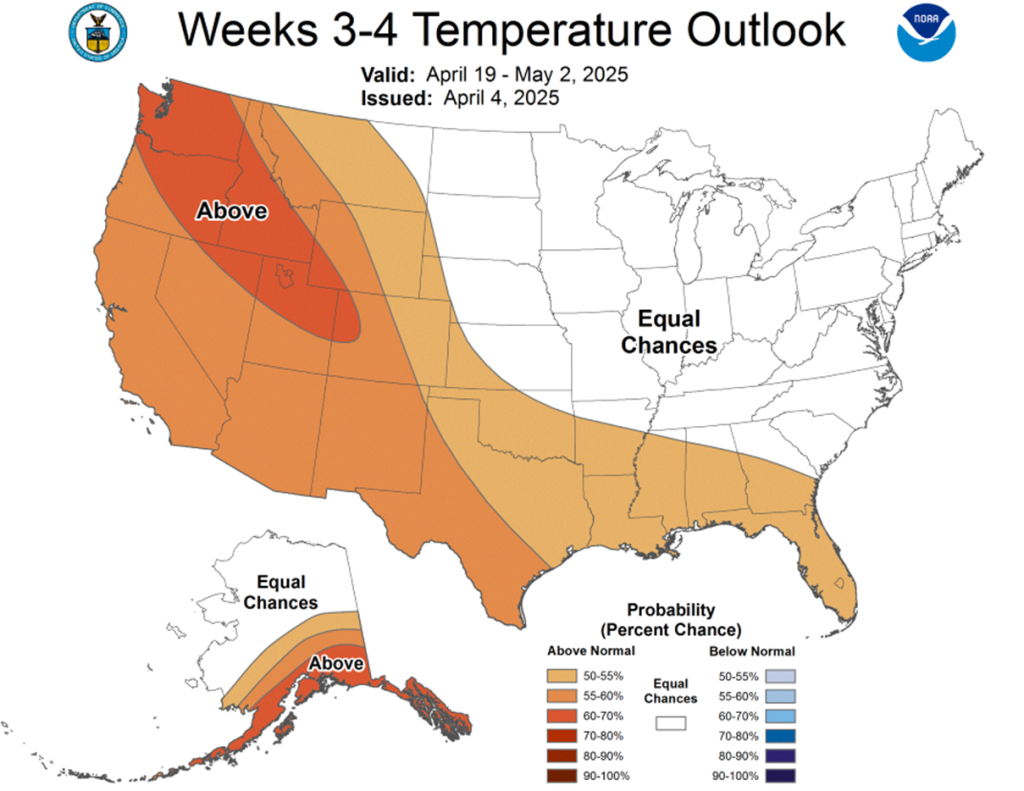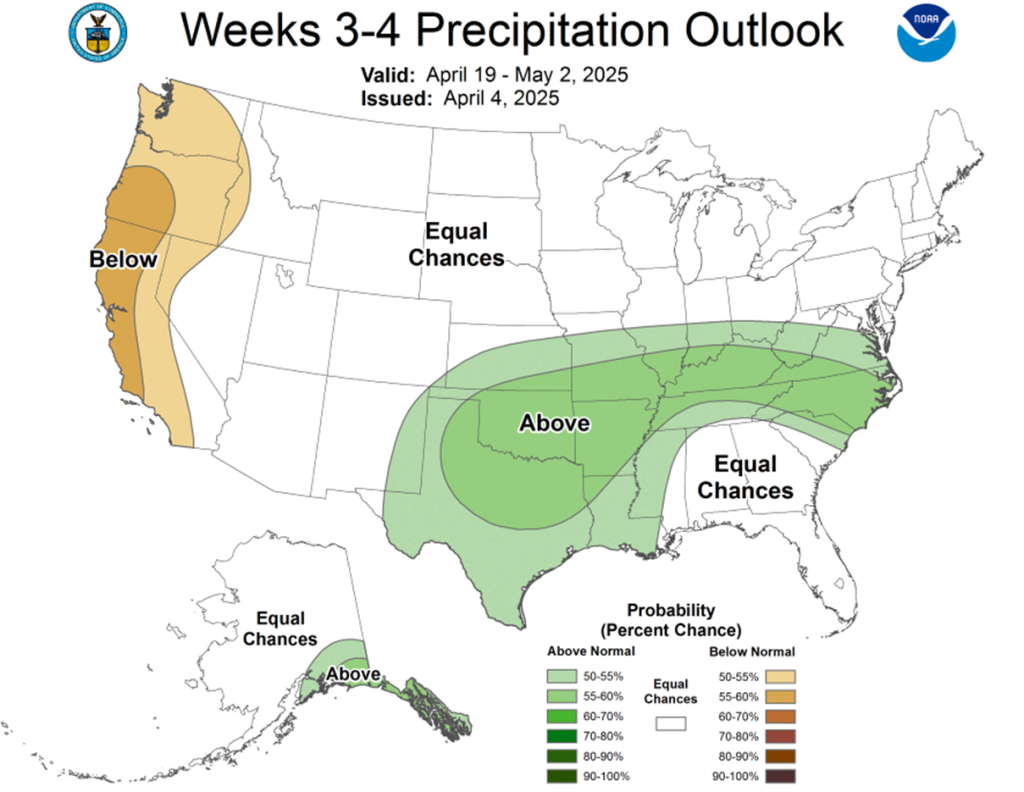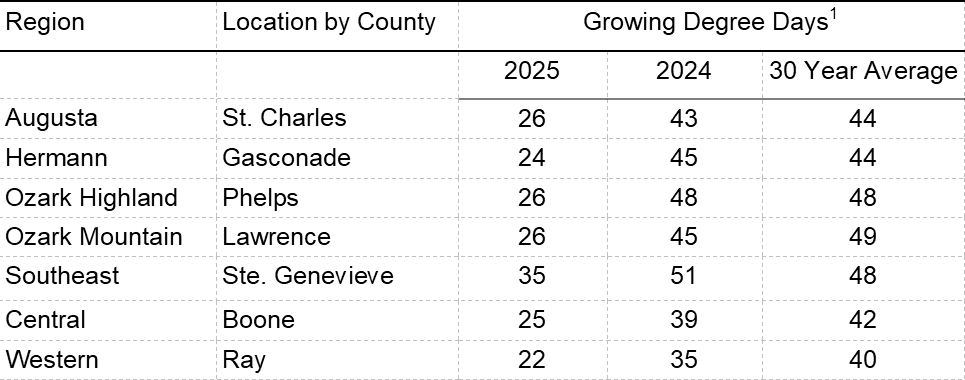Published on
Updated on

Vinews
Viticulture Information News
Week of 7 April, 2025
Columbia, MO
Contents:
- Cool wet conditions and bud break advancing – be ready to protect against Phomopsis Cane and Leaf Spot (Phomopsis viticola)
- Weeks 3-4 Temperature Outlook
- Weeks 3-4 Precipitation Outlook
- Nominations for Missouri Wine and Grape Board – Technical Committee
- Cumulative Growing Degree Days for Seven Grape Growing Regions of Missouri from April 1 to April 7, 2025
Cool wet conditions and bud break advancing—be ready to protect against Phomopsis Cane and Leaf Spot (Phomopsis viticola)

Figure 1. Early season protection starts at 1/2-to 1-inch shoots. Photo credit: D. Volenberg.
The start to the growing season is near. Be ready to protect your crop in the early part of the growing season. You want to start clean and stay clean. What often gets missed is early season protection.
With bud break taking place over the span of next two-weeks depending on the cultivar and location, your concern should turn to protecting young tissue after bud break from Phomopsis cane and leaf spot (Phomopsis viticola) infections. Phomopsis spore release and infections occur during cool wet weather. The optimum temperature for shoot and leaf infections is between 60 to 68 degrees F with at least 6 hours of tissue wetness for infection. Average April high temperatures are near 60 degrees F. The extended temperature weather forecast throughout Missouri for April is for near-normal temperatures (Figure 2). The extended precipitation weather forecast throughout Missouri for April is for above normal precipitation (Figure 3). Coinciding with rainfall events is cloudy conditions that result in extending the wetting period of grape tissue. If these weather forecasts hold-up over time, there is a very good chance of extended wetting periods of grape tissue. Near normal April high temperatures coupled with precipitation events is ideal for Phomopsis infections.
To protect grape leaves and shoots from Phomopsis infections a protective fungicide should be applied starting at ½- to 1-inch shoots (Figure1). Fungicide products that provide good protection contain the active ingredient mancozeb (Table 1). Mancozeb also provides excellent protection to black rot (Guignardia bidwellii) and downy mildew (Plasmopara viticola). Some common trade names of mancozeb fungicides are, Dithane M45, Dithane F-45 Rainshield, Manzate Pro-Stick, and Penncozeb 75DF. According to the label of the product, a second application should be made at 3-to 5-inch shoots followed by a third application at 8-to10-inch shoots. Further the label states that applications should continue at 7- to 10-day intervals until fruit set. All mancozeb fungicides have a 66-day pre-harvest interval.
Be good stewards and adjust your sprayers for early season spray applications. Spray nozzles should be directed at the cordons. Other nozzles out of the range of the cordons can be turned off. Reduce fan speed for early season applications. A total of 25 gallons of spray solution should cover an acre of grapes for early season spray applications. A total of 1.5 lbs of a mancozeb product in 25 gallons of water is approximately the same rate as applying 4 lbs of mancozeb product in 75 gallons of water later in the growing season. By applying less mancozeb product in a reduced carrier volume in the early season provides growers a buffer in running up against the maximum use restriction per acre later in the growing season (Table 1).
Table 1. Mancozeb containing products and the use rate, seasonal maximum and Pre-harvest interval.
| Trade Name | Use Rate | Season Maximum | PHI |
|---|---|---|---|
| Product/acre | Lbs product/acre (lbs ai/acre) | Days | |
| Dithane M-45 (62719-387)1 | 1.5-4 lbs/acre | 24 lbs product/acre (19.2 lbs ai/acre) | 66 |
| Dithane F-45 Rainshield (62719-396) | 1.2-3.2 qts/acre | 19.2 qts product/acre (19.2 lbs ai/acre) | 66 |
| Manzate Pro-Stick (70506-234) | 1.5-4 lbs/acre | 24 lbs product/acre (18 lbs ai/acre) | 66 |
| Penncozeb 75DF (70506-185) | 1.5-4 lbs/acre | 25.6 lbs product/acre (19.2 lbs ai/acre) | 66 |
1EPA Registration number.

Figure 2. Temperature forecast for April 19 to May 2, 2025. Image credit: https://www.cpc.ncep.noaa.gov/products/predictions/WK34/

Figure 3. Precipitation forecast for April 19 to May 2, 2025. Image credit: https://www.cpc.ncep.noaa.gov/products/predictions/WK34/
Nominations for Missouri Wine and Grape Board – Technical Committee

The Missouri Wine and Grape Board-Technical Committee (MWGB-TC) is accepting nominations for the MWGB-TC for non-board committee members. If you are interested in nominating someone or self- nominating yourself, please email Dean Volenberg at volenbergd@missouri.edu the following, first and last name, contact information including email and phone number and resume of nominee. Please complete the nomination form found here, Technical Committee Nomination form.
The MWGB-TC has no more than 12 members and can include up to 6 non-board members. The terms of non-board members are four (4) years. Terms commence on the first day of the month following the Board’s approval of their appointment. Non-board committee members may serve consecutive full four-year terms if approved by the board.
If you have further questions, please reach out to Dean Volenberg at volenbergd@missouri.edu or 573-473-0374.
Cumulative Growing Degree Days for the Seven Grape Growing Regions of Missouri from April 1 to April 7, 2025.

1Growing degree days at base 50 from April 1 to April 7, 2025. Data compiled from U2U Decision Support Tools – Corn GDD
To determine the number of growing degree days accumulated in your area since April 1. Use this tool.
Please scout your vineyards on a regularly scheduled basis in an effort to manage problem pests. This report contains information on scouting reports from specific locations and may not reflect pest problems in your vineyard. If you would like more information on IPM in grapes, please contact Dean Volenberg at 573-882-0476 (office) 573-473-0374 (mobile) or volenbergd@missouri.edu